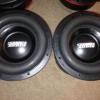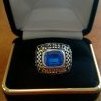-
Posts
16 -
Joined
-
Last visited
About Tony D

- Birthday April 17
Contact Methods
-
Website URL
http://www.damoreengineering.com
-
ICQ
0
Profile Information
-
Gender
Male
Recent Profile Visitors
1961 profile views
Tony D's Achievements
Newbie (1/14)
9
Reputation
-
Hi Christian, tell me more about what happened please. 1. I see that it is about a year old, has it been working fine until now? 2. Did you change anything about your bench setup? Like power supply to AD-1? 3. Have you tried running the AD-1 on 12V battery power alone (no chargers or power supplies)? Thanks! Tony
-
Who's ready for Kfest? We are! Please stop by our booth at the Dallas Convention Center, booth 1127, and check out our demo car. We know that we have been absent from the forum for a bit, we apologize for that. When you see our demo car you will know why, we have been locked in the lab for a couple years and we are ready to show you what we did. We will also have some SMD test equipment on display and a lab bench setup with an Audio Precision and scope. I mean this is KNOWLEDGEfest right? We are bringing some knowledge. If you know my stance on Class D amplifiers, then consider this a hint to the topic of focus. Warning: We will not have a cry closet available, please bring your own tissue.
-
Having a second VM-1 can be a great tool. By plugging one into the 12V (lighter) outlet, you will be reading the voltage at battery/alternator basically because there is very little current flowing to the 12V lighter outlet. Voltage drop is calcuated by this formula Amps X Ohms = Volts, thus is you basically have zero amps flowing, you can not have a voltage drop, and thus you will be reading the battery/alternator voltage. HOWEVER, voltage AT your amplifier(s) can be a totally different thing. Huge currents can flow to the amplifier(s), even though the resistance of the wiring is small, it will still cause a voltage drop. I connected one VM-1 to my lighter, and one right at the amplifier's connections by lengthing the wires going to the VM-1 (you can make these as long as you like without causing any issues or voiding your warranty). With music and subwoofers, I see 0.8V - 1.2V lower at the amplifier. On the dyno I'm seeing 1.6V drop at the amplifier. 1/0 AWG is good, but it ain't that good. I am pretty confident that most people who try this will be very surprised how much voltage drop at the amplifier they have. I challange you to measure yours and post your results. By having multiple units you can check your system like this, and try to correct it by using better distribution/fuses and wiring. If you are wondering, the basic formula for how much more power your amplifier would make with different battery voltage is ((Higher battery voltage / lower battery voltage) ^2 ) x how much power you made at the lower voltage Example, I just dyno'd the T2500.1bdcp in my Jeep. It did 2365 watts into 1 ohm with the battery voltage AT THE AMP at 12.24Vdc. If I could keep 12.6Vdc at the amplifier, the amp should dyno this much power: ((12.6V / 12.24V) ^2 x 2365 watts) This works out to 2506 watts at 12.6V. Rockford rates their power at 14.4V so, clearly this amplifier makes rated power @ 1 ohm and then some. If by some act of God I could keep 13.8V at the amplifier I could get that amp to put out: ((13.8V / 12.24V) ^2 x 2365 watts) This works out to 3006 watts. Now this is only true if you have an amplifier with an unregulated power supply. Some amplifiers, like JL slash series for instance, have fully regulated supplies so this math doesn't apply. Those amplifiers will put out the same power reguardless of the battery voltage within a resonable range.
-
This doesn't sound right, please send the unit to us as soon as possible. We will take care of it and get it right back to you. D'Amore Engineering 340 Paseo Camarillo #202 Camarillo, CA 93010 I'll get it sent out today. Should I include a note or something with the package? Just your return address
-
Funny I was going to call it the Clip Detector too, but then realized it's much more than that. It will detect any distortions to the original signal. As far as input, it will work with accuracy up to 140Vrms in, which would work out to about 20,000 Watts into 1 ohm. It won't be damaged until 200Vrms+. So sure it will handle the warhorse.... i'm wondering if the warhorse can handle it Lol, what i'm saying is I don't have any experience with the warhorse personally and I don't know how clean (or dirty) the output is. It may exceed 1.0% THD long before it nears max power. I don't know this for a fact though. Just making the point that this is a Distortion meter.
-

The History of the Rockford T15K.....From its designer.
Tony D replied to meade916's topic in Amplifiers
Steve, was just checking out your build pics with the (2) T15kW's. You are a nut. Love ya man!!! Tony D'Amore





a.thumb.jpg.b1fb00e4ce6236214d6b35c82464aff9.jpg)
